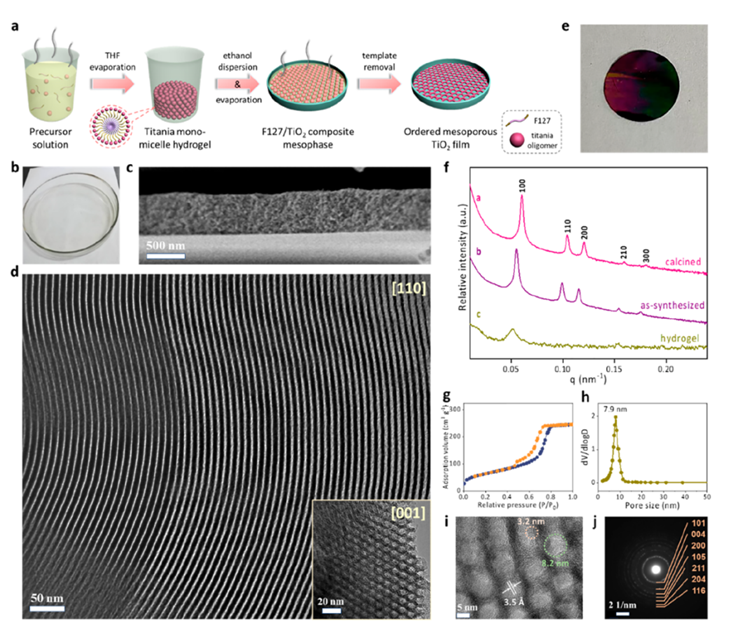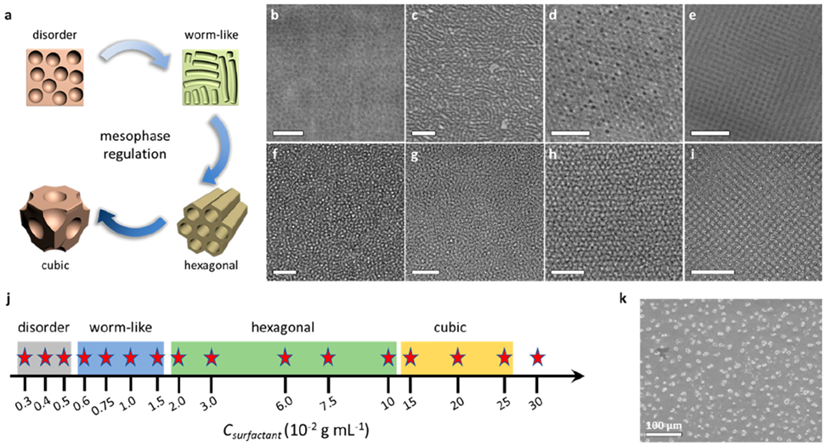Crystalline mesoporous materials, due to their fascinating mesoporosity and crystallinity, promise various applications in such aspects as optoelectronics, energy storage and conversion devices. Certain strategies, such as sol−gel method, hydrothermal process and evaporation method, have been developed for creating well-defined crystalline mesoporous metals, oxides and other compounds. Unfortunately, the construction of crystalline mesoporous membranes/films currently remains a great challenge. There are two reasons for it. First, the crystallization at high temperature unavoidably leads to the segregation and shrinkage of as-prepared membranes due to the vanishing of their interaction with substrates. Second, the undesired control of parameters of mesostructures is majorly ascribed to the fundamental issues in crystalline mesostructures: fast hydrolysis of metal precursors, weak interaction of precursors and surfactants, and mesostructural collapse during crystallization. It is still hard to realize the precise, controlled self-assembly of crystalline membranes.
Herein, Zhao’s research team presented a stepwise monomicelle assembly method and successfully constructed highly ordered mesoporous crystalline TiO₂ membranes(Figure. 1). Through first obtaining a monomicelle hydrogel and then assembling to form ordered mesoporous membranes, this stepwise control allows for a broader reactive region with a high precursor concentration and sufficient assembly time and a precise control of mesoporous membrane’s order, mesostructure, size and thickness. In addition, the method can be applied in different substrates and has good expansibility. Moreover, the mesoporous TiO₂ membrane shows the great potential in pseudocapacitance sodium storage.

Figure 1 Synthesis and characterization of highly ordered mesoporous TiO₂ membrane
It is worth noticing that through regulating the concentration of monomicelle gel the mesoporous membranes with different mesostructures(Figue 2) can be obtained. With the increasing concentration, the mesostructure gradually transitions from disordered to worm-like (short-range ordered), hexagonal (p6mm) and cubic (Im3̅m) structures.
Figure 2. Accurate TiO mesostructural regulation and all scale bars of 100 nm
Zhao Dongyuan, academician of CAS and Research Fellow Lan Kun who are with the College of Energy Materials and Chemistry of IMU, have been focusing on the assembly and mechanism of crystalline mesoporous materials. In the previous research, based on the developing monomicelle intermediate, with the second assembly control through different external forces and space, the research team has created a series of new mesoporous TiO materials with the adjustable micro-morphology, mesostructures and parameters and promise various applications in energy. The synthesis and innovation of this kind of material provide the opportunity for the expansion of mesoporous material and its potential value.
The research proposes a new method of stepwise assembly for the growth of highly ordered mesoporous TiO membranes and provides a new path for the production of crystalline mesoporous membrane devices. The research result has been published in JACS Au, a top journal in chemistry (DOI: 10.1021/jacsau.3c00007). The result is titled “Stepwise Monomicelle Assembly for Highly Ordered Mesoporous TiO₂ Membranes with Precisely Tailored Mesophase and Porosity”. The first author of the article is Lan Kun, research fellow with the College of Energy Materials and Chemistry of IMU. And the corresponding authors are Zhao Dongyuan, academician of CAS, who is with IMU and Wei Qiulong, associate professor with Xiamen University.

